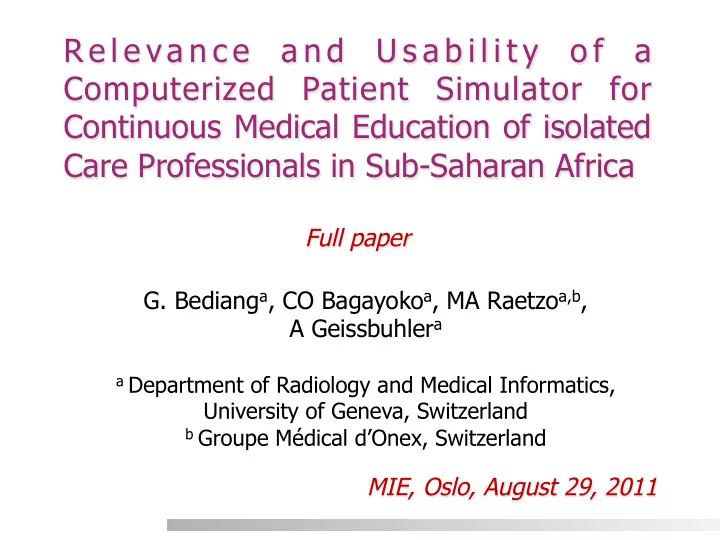

R e l e v a n c e a n d U s a b i l i t y o f a Computerized Patient Simulator for Continuous Medical Education of isolated Care Professionals in Sub-Saharan Africa Full paper G. Bediang a , CO Bagayoko a , MA Raetzo a,b , A Geissbuhler a a Department of Radiology and Medical Informatics, University of Geneva, Switzerland b Groupe Médical d’Onex, Switzerland MIE, Oslo, August 29, 2011
Introduction ¤ Many guidelines are developed aimed at reinforcing the capacity of healthcare professionals (HCP). ¤ There are many difficulties for their application, especially in developing countries. ¤ Inadequacy with the local conditions ¤ Only based on traditional tools of CME ¤ Insufficient consideration of the operating environment of healthcare professionals ¤ “How do we adapt and teach medical guidelines in our local context?” MIE 2011, Bediang et al.
Introduction ¤ Many studies outline the importance and the potential of virtual patient in medical education ¤ Objective: Explore the relevance and usability of using a computerized patient simulator as a continuing medical education tool for HCP situated in rural areas of French-speaking Sub-Saharan Africa, for improving diagnostic processes and decision-making in the management of patients. ¤ Sites: Cameroun and Mali (RAFT-Member countries) MIE 2011, Bediang et al.
Material ¤ Virtual Internet Patient Simulator (VIPS) ¤ Web application ¤ Main learning activity: Medical consultation. ¤ Based on diagnostic pathway and decision analysis tools developed for improving skills of general practitioners in Switzerland. ¤ Interface: - Conversational - Graphical MIE 2011, Bediang et al.
Methods ¤ Identification of clinical situations (errors of management) ¤ Creation of Height (8) clinical vignettes (CV) ¤ Diabetes, PID, Ectopic pregnancy, Placenta Praev., etc. ¤ Implementation of CV on VIPS ¤ Assessment of relevance and usability of VIPS ¤ Healthcare professionals: Cameroon, Mali ¤ Consultation of CV on VIPS program ¤ Questionnaire ¤ Statistical analysis: EpiData Entry 3.1, SPSS 17.0 MIE 2011, Bediang et al.
Results Participants ¤ 88 people ¤ Mali: 54 %, Cameroon: 46 % ¤ Six groups ¤ Medical Doctors: 59% ¤ Medical Students: 23% ¤ Nurses: 8% ¤ Others: 10% ¤ Average age: 30,3±7,1 Years ¤ Clinical experience: 43% had between 3-6 years MIE 2011, Bediang et al.
Results Relevance of clinical vignettes ¤ Relevance of general content of CV: 96,1% of users (..) ¤ Ability to find items they wanted: 66,7%.. ¤ Appropriateness of answers’ items: 94,8%.. ¤ Completeness of CV: 76,8%.. ¤ Cases of CV adapted to local context: 74,7%.. ¤ Appropriateness of bibliographic references (BR): 87,4%.. ¤ Utility of BR to understand the errors made: 90,1%... MIE 2011, Bediang et al.
Results Usability of VIPS Program ¤ Time (30min-1h) to resolve one case on VIPS: 51,9%.. ¤ VIPS is easy to use in general: 76,8%.. ¤ Ease to progress in the case: 63,1%.. ¤ Ease to navigate between the steps of the case:63,9%.. ¤ Ease to ask questions/take decisions: 55%.. ¤ VIPS is an entertaining way of learning: 96,3%.. ¤ Enjoyment to resolve the cases: 97,6%.. MIE 2011, Bediang et al.
Discussion ¤ An adapted computerized patient simulator can be used as an initial and CME tool for isolated HCP in French- speaking Sub-Saharan Africa. ¤ The support for the deployment of this activity in district hospitals is required. ¤ The identified keys for the success of this project: ¤ Sufficient training and appropriation of tools/concepts ¤ Development of computers skills ¤ Access to computers and the Internet ¤ Availability of power electricity MIE 2011, Bediang et al.
Conclusion ¤ Adaptation of this approach in the isolated districts hospitals in Sub-Saharan Africa is possible. ¤ Although, additional efforts to better tailor are still needed. ¤ The limitations exit for the generalization of our results ¤ Small number of participants ¤ Only two countries was concerned ¤ Only address the usability and relevance aspects. MIE 2011, Bediang et al.
Thank you for your kind attention georges.bediang@hcuge.ch For more information on RAFT : http://raft.hcuge.ch 11
Recommend
More recommend